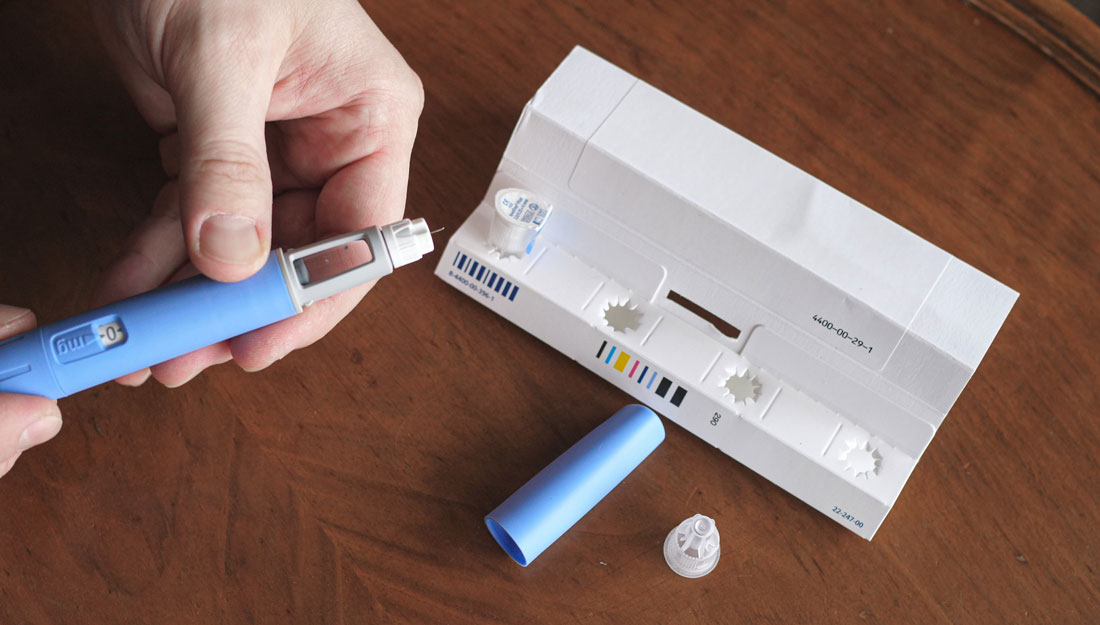- Shelby Purdy
- Health Tips, Healthy Living, Pharmacy, Show on VR homepage
Pharmacists explain diabetes drugs going viral for weight loss
Celebrities and influencers claim diabetes drugs are helping them lose weight, but now they're in short supply for people who need them

Demand for diabetes drugs like Ozempic and Wegovy for weight loss has led to a shortage.
Celebrities and influencers have taken to social media touting the weight loss benefits of GLP-1 diabetes drugs like Ozempic and Wegovy. But the demand for these drugs has led to a shortage, making it difficult for people who have type 2 diabetes to get the medicine they need to control their blood sugar.
We sat down with two clinical assistant professors at the Texas A&M University Irma Lerma Rangel School of Pharmacy—Pooja Patel, PharmD, and Andrew Tenpas, PharmD, RPh—to learn more about these drugs, what they do, and who they’re right for.
What are GLP-1 drugs?
Glucagon-like peptide-1 (GLP-1) receptor agonists are a class of medications first introduced in 2005. The market for this class has grown significantly in recent years.
Currently approved GLP-1 receptor agonists, also referred as “GLP-1 RAs” or “GLP-1s” include:
- Dulaglutide (Trulicity) (weekly)
- Exenatide extended release (Bydureon bcise) (weekly)
- Exenatide (Byetta) (twice daily)
- Liraglutide (Victoza) (daily)
- Liraglutide (Saxenda) (daily) – for weight loss
- Lixisenatide (Adlyxin) (daily)
- Semaglutide (Ozempic) (weekly)
- Semaglutide (Rybelsus) (daily by mouth)
- Semaglutide (Wegovy) (weekly) – for weight loss
Who are these drugs for?
Initially, this class was used primarily for blood sugar control in patients with type 2 diabetes. However, as more and more trial data has been gathered, they have become increasingly prescribed for weight loss, cardiac and kidney protection, and even non-alcoholic steatohepatitis, a type of fatty liver disease in people who do not drink heavily.
All GLP-1 RAs are currently approved by the Food and Drug Administration (FDA) for use to improve blood sugar control in patients with type 2 diabetes, as an adjunct to diet and exercise. Certain GLP-1 RAs are also FDA approved to reduce the risk of major adverse cardiovascular disease in patients with type 2 diabetes and established cardiovascular disease. Two of these GLP-1 RAs, semaglutide and liraglutide, are approved for weight loss for specific populations under the brand names Wegovy and Saxenda respectively.
How is it taken?
Almost all members of the GLP-1 drug class are subcutaneous injections, available as either single-dose or multidose pens. Though earlier members of the class are once daily injections, newer members like Wegovy and Ozempic are dosed as once weekly injections. At present, one member of the class—Rybelsus (which also contains the active ingredient semaglutide)—comes as a daily tablet, usually taken at the start of the day.
How do drugs like this work to manage blood sugar levels in people with type 2 diabetes?
GLP-1 RA drugs mimic the action of a hormone called glucagon-like peptide 1. There are four ways these medications work to help manage blood sugar levels in people with type 2 diabetes:
- Help your body release insulin when needed
- Keep your liver from releasing too much sugar in your blood
- Help slow food leaving your stomach reducing blood sugar spikes
- Help your brain tell your body that you are full
Are these drugs approved for weight loss?
Technically, it is not illegal for prescribers like physicians, nurse practitioners or physicians’ assistants to prescribe medications “off-label,” or for something other than an FDA-approved indication. In some cases, medications have a rather narrow range of “approved” indications, but they are frequently used off-label. Since they share the same active ingredient (semaglutide), Ozempic and Wegovy are FDA-approved for treatment of type 2 diabetes, obesity and prevention of cardiovascular disorders. Their off-label uses include non-alcoholic steatohepatitis.
“Whether patients and prescribers use these medications ‘off-label’ isn’t necessarily my concern, as long as there is a sound medical rationale, they are used responsibly by the patient, and patients are regularly monitored by a prescriber or pharmacist,” Tenpas said.
“History has shown that the timeline to get a drug approved may take years, and often times, we do have literature available that may encourage a health care provider to safely initiate a medication for an off-label indication,” Patel said. “This is the reason why several medications have more than one indication/use. However, I strongly believe that it is important for health care providers to be up-to-date on ongoing research and involve the patient in shared decision making while weighing the risk vs. benefit for each individual.”
How do health care providers monitor patients on these drugs?
Before initiating a GLP-1 RA, health care providers must ensure patients do not have a personal or family history of thyroid cancer, pancreatitis or gallbladder disease. Once initiated, providers should monitor for common side effects, blood sugar readings, body weight, kidney function, triglycerides, signs and symptoms of pancreatitis, gall bladder disease, and worsening of diabetic retinopathy.
It is advisable, especially when starting either Wegovy or Ozempic medication, for patients to maintain close contact with their prescriber or pharmacist. The reason for this is that gastrointestinal (GI) upset (including nausea, vomiting and diarrhea), weight loss or dramatically decreased appetite may occur. Prescribers and pharmacists can help patients to recognize what is normal, what is abnormal (and potentially serious), and how to best navigate those side effects.
“At my practice, when I start a patient on Ozempic, I usually follow up with them within the first few weeks,” Tenpas said. “In many cases, if a patient is going to have intractable GI upset, it might be seen within the first few weeks. Generally, the longer that a patient is on a GLP-1 medication, the better it is tolerated. However, the risk for side effects is always present whenever patients increase to a higher dose (for example, from 0.5 mg to 1 mg) or restart the medication after a long period away from it.”
As a pharmacist, have you seen a surge in demand in recent months?
“Speaking from personal experience, I have definitely seen a significant increase in recent months in the number of patients asking questions about Ozempic and other GLP-1 drugs,” Tenpas said. “Between television commercials and testimonials all over social media, it’s hard to avoid exposure to this class. At my practice site, the McAllen VA, we have very strict criteria for when or if patients even qualify for Ozempic.”
“GLP-1 RAs are an excellent treatment option for patients with type 2 diabetes, as well as those patients with diabetes and known cardiovascular disease,” Patel said. “They have a low risk of hypoglycemia and help tremendously with weight loss. So, it is an attractive agent that we can utilize for our patients with type 2 diabetes. However, there has been a tremendous surge in its demand after people started talking about their weight loss success with GLP-1 RAs on social media.”
Some reports state there is shortage of Ozempic. How might this affect diabetes patients who are high risk?
“Ozempic shortages have certainly impacted many of my VA patients,” Tenpas said. “For some patients, they are unable to regularly take the medication due to significant gaps or uncertainty as to when the patient or our pharmacy might receive it. In other cases, we have reservations about even starting qualified patients on the medication in the first place due to these shortfalls. At the end of the day, many patients are unable to regularly obtain a potentially beneficial medication, which is extremely disappointing for all parties.”
“Ninety-five percent of the patients that I manage in my clinic are high risk since they are either pre- or post-transplant patients,” Patel said. “I have had several patients that have had issues with obtaining Ozempic. Pharmacies either do not have Ozempic all together or only have a particular strength.
“Not just Ozempic, but another GLP-1 RA, Trulicity, has also been difficult to procure and is backordered,” she continued. “Unlike other medications where we can tell patients to take more of the lower strength medication to equal their recommended dose, (for example, take two 1 mg injections instead of one 2 mg injection), I cannot do that with these GLP-1RAs as some insurances do not allow that. This has led to several of my patients being out of the medication for several weeks, or using less effective lower doses or having to switch to less optimal agents to maintain their sugars with their goal range.”
What should people do if they think they should be taking one of these drugs?
“I would advise patients to discuss their interest with their physician, prescriber or pharmacist,” Tenpas said. “Those individuals can help patients—based on their clinical experience—to decide if a GLP-1 medication like Ozempic or Wegovy is recommended.
“I also recommend that patients conduct their own research,” he continued. “There are a number of websites—including ones created by the manufacturer of these drugs—that do a great job of explaining what the medications do, what side effects patients can expect, and even how much they might cost. Lastly, since GLP-1 medications like Ozempic are relatively new and can be somewhat expensive, I would encourage interested patients to call their insurance company and ask a representative what their estimated copay might be.”
Always consult with your qualified health care professionals to meet your individual needs.
Media contact: media@tamu.edu


